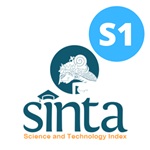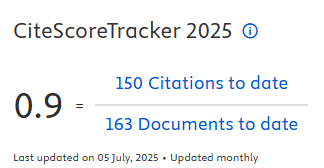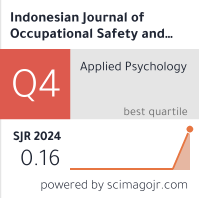Personal Protective Footwear and The Risk of Tinea Unguium among Lojejer Villager Farmers

Downloads
Introduction: Tinea unguium is a nail infection caused by dermatophytes, characterized by nail discoloration, thickening, and brittleness. Farmers, often exposed to prolonged wet conditions, are at higher risk of this infection. The use of appropriate footwear is recommended to mitigate this risk. However, inadequate personal protective equipment (PPE) usage makes farmers more susceptible to Tinea unguium. Research on Tinea unguium among farmers in Lojejer Village is limited, with differing result on the link between wearing footwear as PPE and the occurance of Tinea unguium. This study aimed to investigate the relationship between the use of footwear as PPE and the incidence of Tinea unguium among farmers in Lojejer Village. Methods: This study uses a cross-sectional observational design. It involved 98 respondents determined using Slovin’s formula. Data were collected through interviews and nail samples, which were subjected to fungal culture on sabouraud dextrose agar (SDA) medium and microscopic examination with lactophenol cotton blue staining. Fisher’s Exact tests were used for analysis. Results: Results revealed that seven farmers (7.14%) were affected by Tinea unguium, predominantly males (85.8%) aged 45–64 years (57.1%). Trichophyton rubrum was identified as the primary dermatophyte, with Aspergillus sp. as a contaminant. Statistical analysis showed no significant relationship between footwear usage, personal hygiene, or footwear hygiene and Tinea unguium (p-values > 0.05). Conclusion: The study found no significant association between footwear use, hpersonal hygiene, and footwear hygiene with Tinea unguium incidence among farmers in Lojejer Village
Anggraeni, F.K., Krisnarto, E. and Arfiyanti, M.P. (2023) ‘Hubungan Perilaku Personal Hygiene Dengan Kejadian Onikomikosis Pada Kuku Tangan Dan Kuku Kaki Petani’, Jurnal Ilmu Kedokteran dan Kesehatan, 10(10), pp. 2998–3004. Available at: https://doi.org/10.33024/jikk.v10i10.10516.
Ayu, I.G. et al. (2024) ‘Tinea Unguium in a Child Caused by Trichophyton Rubrum : A Case Report’, Bali Medical Journal, 13(3), pp. 1472–1476. Available at: https://doi.org/10.15562/bmj.v13i3.5205.
Falotico, J.M. and Lipner, S.R. (2022) ‘Updated Perspectives on the Diagnosis and Management of Onychomycosis’, Clinical, Cosmetic and Investigational Dermatology, 15, pp. 1933–1957. Available at: https://doi.org/10.2147/CCID.S362635.
Fonna, T.R. and Haura, J. (2023) ‘Gambaran Klinis pada penderita Tinea Unguium, Penyuluhan di Puskesmas Syamtalira Bayu, Aceh Utara’, AUXILIUM: Jurnal Pengabdian Kesehatan, 1(1), pp. 6-10.
Hasan, Z.A. et al. (2022) ‘Lontara’, Journal of Health Science and Technology, 3(1), pp. 38–49.
Husen, F., Khasanah, N.A.H. and Ina Ratnaningtyas, N. (2024) ‘Identifikasi Jamur Non-Dermatofita Penyebab Onikomikosis Kuku (Tinea Unguium) Pada Petani Padi’, Jurnal Media Analis Kesehatan, 15(1), pp. 35–45. Available at: https://doi.org/10.32382/jmak.v15i1.586.
International Labour Organization (2023) Kesehatan dan Keselamatan pada Sektor Tekstil, Pakaian, Kulit dan Alas Kaki. Jakarta: International Labour Organization .
Kamil et al. (2021) ‘Studi Literature Agen dan Faktor Risiko Penyebab Tinea Unguium Pada Infeksi Kuku Kaki Petani’, Jurnal Teknologi Laboratorium Medik Borneo, 1(1), pp. 34–41.
Karunarathna, I. et al. (2024) ‘The Dermatophyte Connection : Tinea Unguium and’, Conference: Uva Clinical Dermatology, (November), pp. 1-10. Available at: https://doi.org/10.13140/RG.2.2.28005.82407.
Merad, Y. et al. (2021) ‘Aspergillus Genus and its Various Human Superficial and Cutaneous Features’, Pathogens, 10(6), pp. 1–17. Available at: https://doi.org/10.3390/pathogens10060643.
Mufida, D.C. et al. (2024) ‘The Relationship Between Personal Hygiene and The Prevalence of Tinea Unguium Infection Among Farmers in Jember District’, Jurnal Profesi Medika : Jurnal Kedokteran dan Kesehatan, 18(1), pp. 44–50. Available at: https://doi.org/10.33533/jpm.v18i1.7514.
Naqsyabandi (2021) ‘Identifikasi Fungi Penyebab Tinea Unguium pada Kuku Kaki Petani Padi di Dusun Sekarum Desa Gandarum Kecamatan Kajen Kabupaten Pekalongan’, Jurnal Medika Husada, 1(2), pp. 19–23.
Nurfadilah, A. et al. (2021) ‘Gambaran Keberadaan Tinea Unguium Pada Kuku Kaki Petani Padi Di Kelurahan Sungai Selincah Kecamatan Kalidoni Kota Palembang Tahun 2021’, Jurnal Fatmawati Laboratory & Medical Science, 1(1), pp. 37–48. Available at: https://doi.org/10.33088/flms.v1i1.184.
Orr, R. et al. (2022) ‘The Impact of Footwear on Occupational Task Performance and Musculoskeletal Injury Risk: A Scoping Review to Inform Tactical Footwear’, International Journal of Environmental Research and Public Health, 19(17), pp. 1-39. Available at: https://doi.org/10.3390/ijerph191710703.
Pang, S.M. et al. (2018) ‘Tinea Unguium Onychomycosis Caused by Dermatophytes: A Ten-year (2005–2014) Retrospective Study in a Tertiary Hospital in Singapore’, Singapore Medical Journal, 59(10), pp. 524–527. Available at: https://doi.org/10.11622/smedj.2018037.
Rachmad, B., Apriani and Anggiani, Y. (2021) ‘Identifikasi Jamur Tinea Unguium pada Kuku Kaki Pekerja Pabrik Tahu dan Oncom di Kalideres Jakarta Barat’, Jurnal Medical laboratory, 1(1), pp. 1–5.
Rachmawati, F., Nursidika, P. and Fitrianingsih, P. (2022) ‘Identifikasi Jamur Trichophyton sp. Penyebab Tinea Unguium Pada Petani Desa Mekarluyu Kabupaten Garut’, Jurnal Penelitian Saintek, 2(27). Available at: https://doi.org/10.21831/jps.v2i27.52528.
Rahmawati, A., Oktavia, R. and Saftarina, F. (2024) ‘Penatalaksanaan Pelajar Usia 13 Tahun Dengan Tinea Unguium Melalui Pendekatan Kedokteran Keluarga Atika’, Jurnal Penelitian Perawat Profesional, 6, pp. 2495–2508.
Rahmayanti, Hadijah, S. and Darmawati (2024) ‘Edukasi Jamur Kuku (Tinea Unguium) Pada Lansia Di Uptd Rumoh Sejahtera Geunaseh Sayang Desa Lamglumpang Kecamatan Ulee Kareng Kota Banda Aceh’, Jurnal Kreativitas Pengabdian Kepada Masyaraka, 7(10), pp. 4517–4529.
Riyadi, E., Batubara, D.E. and Pratiwi Lingga, F.D. (2020) ‘Hubungan Higiene Perorangan Dengan Angka Kejadian Dermatofitosis’, Jurnal Pandu Husada, 1(4), p. 204. Available at: https://doi.org/10.30596/jph.v1i4.5307.
Sariyanti, M. et al. (2021) ‘Identification of Dermatophyte Fungi Causing Tinea pedis and Tinea unguium in Malabero Coastal Communities, Bengkulu’, Microbiology Indonesia, 15(1), pp. 21–26. Available at: https://doi.org/10.5454/mi.15.1.4.
Shankar, A. and Thomas, J. (2021) ‘Dermatophytosis in a Suburban Hospital-A Study on Distribution and Clinical Types According to Age and Sex’, Journal of Pharmaceutical Research International, 33, pp. 110–113. Available at: https://doi.org/10.9734/jpri/2021/v33i45a32722.
Suhartini, Aina, G.Q. and Rahayu, F.E.S. (2022) ‘Hubungan Penggunaan Sepatu Boot Dan Prevalensi Trichophyton sp Pada Penambang Batu Bara’, Jurnal Ilmu Kesehatan, 5(2), pp. 147–152.
Triana, D., Nawaliya, A. and Sinuhaji, B. (2020) ‘Kejadian Infeksi Trichophyton Mentagrophytes Terkait Personal Hygiene Antara Nelayan Dengan Pengolah Ikan Rumahan Di Wilayah Pesisir Kota Bengkulu’, Jurnal Kesehatan Kusuma Husada, pp. 74–81. Available at: https://doi.org/10.34035/jk.v12i1.582.
Tsuboi, R. et al. (2021) ‘Validation of a Lateral Flow Immunochromatographic Assay for Tinea Unguium Diagnosis’, Journal of Dermatology, 48(5), pp. 633–637. Available at: https://doi.org/10.1111/1346-8138.15838.
Umar, F. et al. (2023) ‘Hubungan Antara Penggunaan Alat Pelindung Diri Dan Personal Hygiene Dengan Kejadian Onikomikosis Pada Petani Desa Kedokan Gabus’, Jurnal Kesehatan Siliwangi, 4(1), pp. 155–164. Available at: https://doi.org/10.34011/jks.v4i1.1475.

This work is licensed under a Creative Commons Attribution-NonCommercial-ShareAlike 4.0 International License.

In order to be accepted and published by The Indonesian Journal of Occupational Safety and Health, Author(s) who submit an article should complete all the review process. The copyright of received articles assigned to the The Indonesian Journal of Occupational Safety and Health and Department of Safety and Health, Universitas Airlangga as publishers of the journal. The intended copyright includes the rights to publish articles in various forms (including reprints).
The Editorial Team of The Indonesian Journal Of Occupational Safety and Health and Department of Safety and Health strive to ensure that no errors occur in the articles that have been published, both data errors and statements in the article.
Users of this website will be licensed to use materials from this website following the Creative Commons Attribution-NonCommercial-ShareAlike 4.0 International License. No fees charged. Please use the materials accordingly.
------------------------------------------------------------------------------------------------------------------------------------------------------------------------------------------
Attribution ” You must give appropriate credit, provide a link to the license, and indicate if changes were made. You may do so in any reasonable manner, but not in any way that suggests the licensor endorses you or your use.
NonCommercial ” You may not use the material for commercial purposes.
ShareAlike ” If you remix, transform, or build upon the material, you must distribute your contributions under the same license as the original.







 How to Submit Articles in OJS
How to Submit Articles in OJS

























